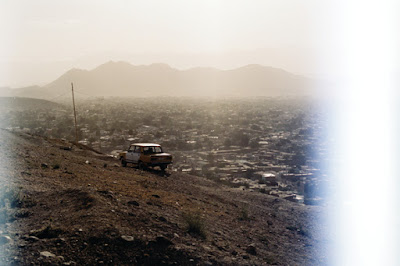36 inches x 24 inches
Photographs
Jeannette Gaussi, Afghanistan / Berlin
---
It's a pity that Jeanno could not make it to the Serendipity Arts Festival in Goa, 2016. Having done multiple rounds of the VISA office, Jeanno was denied VISA to India for no particular reason. To some extent, this also echoes the strained relationship between the countries of the subcontinent. Infact, Jeanno has regularly visited India in the past, and no one can really predict what parameters work in visa approvals in cross the subcontinent borders. Inspite of this drawback, she was able to send us images of a project that she undertook in 2007, which we could print and install at the exhibition.
Jeanno sent us some vivid images of Kabul. One can see in the grainy, burnt out images the lonely landscapes of Afghanistan. Large dry stretches of land are encompassed within the fold of distant mountains that also contain the city. The photographs have serendipitously desecrated, (as Jeanno informs us), much like the landscape itself. Shot from a distance, most photographs try to capture the overwhelming silence of the city. In the selection of images, one sees little sign of life, creating a sense of strangeness and fear. Is this place desolate? Do people only stay inside? Is it too aloof to be outside? Are the outdoors safe? These are questions that have come to grip me on a primary viewing of the images.
The washed out photographs on one hand metaphorically represent the unfamiliarity of a distant unknown landscape, and on the other, allow the viewer to fill in the "gaps" with their own imagination. Phenomenally, they evoke simultaneous sensations of tranqulity and fear. Has the city calmed down after a turmoil, or is this the silence before a large upheaval? The faded photographs leave us in suspended time - sometimes leading into, and sometimes leaving us within Kabul's political geography. They may also give us an impression that the photographs were taken by a fugitive - rather they make the viewer feel like one...creating a sense of suspense and secrecy. But more than any thing else, the photographs become an apt mirror of Kabul's past, as much as the artist's.
Artist Statement:
I was photographing Kabul, but had no knowledge that my camera was faulty until I returned home to find that all the pictures had been marred by a black or white shadow.
But there was serendipity in the incident because it highlighted the existence of my past within my present. The past was erased while my present was visible.
- Jeanno Gaussi


















































